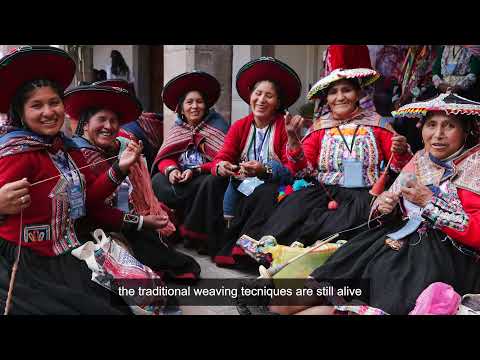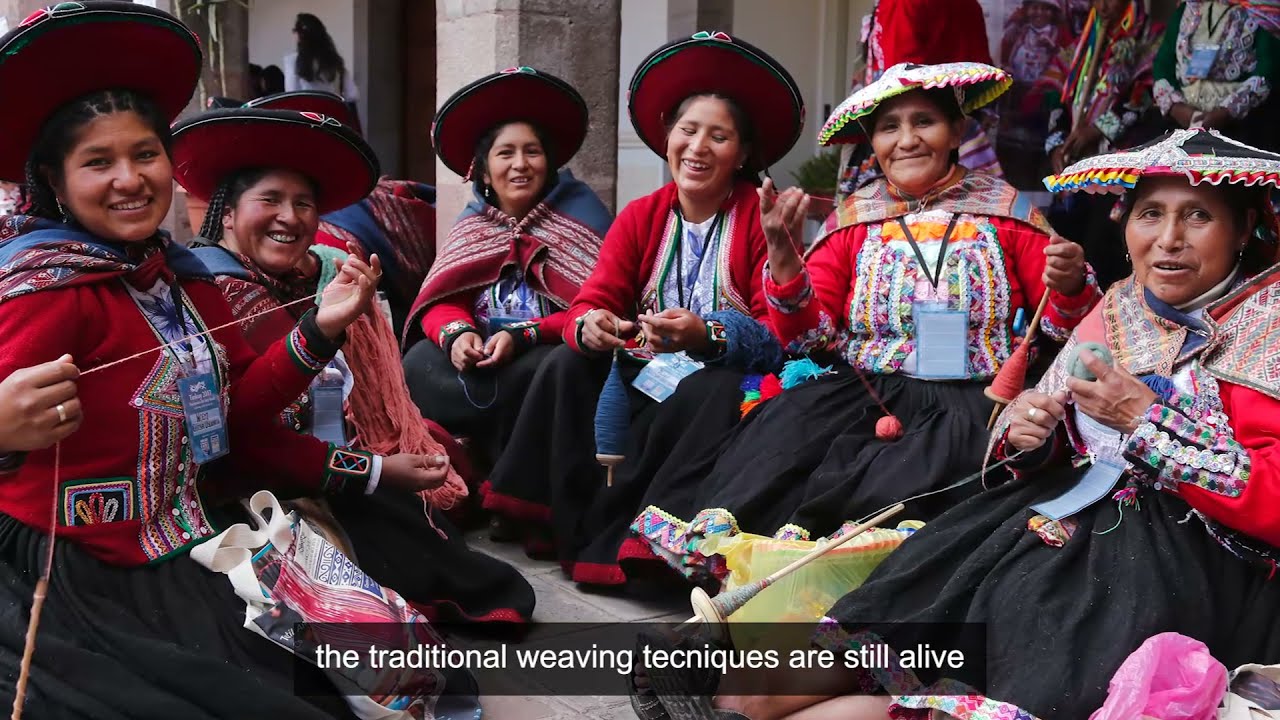Peruvian fabric is a rich and vibrant art form that encapsulates the diverse and colorful culture of Peru. With a history dating back centuries, these textiles are not just mere pieces of cloth, but rather intricate works of art that tell stories of ancient civilizations and traditions. Every thread and pattern woven into these fabrics represents the craftsmanship and creativity of the Peruvian people. The colors used are incredibly vivid and bold, reflecting the vibrant landscapes and indigenous flora and fauna of the region. From deep blues and greens reminiscent of the Pacific Ocean to fiery reds and oranges inspired by the Andean sunsets, these colors create a visual feast for the eyes. The patterns are equally mesmerizing, incorporating geometric shapes, mythical creatures, and symbols that are deeply rooted in Peruvian folklore and mythology. Each pattern carries a unique meaning and serves as a cultural language, passed down through generations. The textures of these fabrics are also noteworthy, with a variety of weaving techniques employed to create intricate designs and textures that are both visually stunning and tactilely pleasing. Whether it's the softness of alpaca wool or the durability of cotton, these textures add depth and character to the already captivating Peruvian fabric. Immerse yourself in the world of Peruvian fabric and experience the magic and beauty that these textiles bring to life.

The Rich Cultural Heritage of Peruvian Fabric
Peruvian fabric is renowned worldwide for its exquisite craftsmanship, vibrant colors, and intricate designs. Rooted in the country's rich cultural heritage, Peruvian textiles have a long history dating back thousands of years. From the ancient Incas to modern-day artisans, the art of weaving has been passed down through generations, preserving traditional techniques and patterns that continue to captivate admirers around the globe.
The Art of Andean Weaving
Andean weaving is a treasured tradition that has been perfected over centuries. The process involves spinning raw fibers into yarn and then intricately weaving them on a loom. The materials used in Peruvian fabric vary, from alpaca and llama wool to cotton and silk. Each fiber brings its own unique qualities, resulting in textiles of different textures, warmth, and durability. The dexterity and skill required for Andean weaving are truly remarkable.
The Symbolism of Peruvian Textiles
Peruvian textiles are not only visually stunning but also hold deep cultural significance. The intricate patterns and motifs found in these fabrics often represent the beliefs, mythology, and traditions of the indigenous communities. For example, the chakana symbol, also known as the Inca Cross, is frequently woven into textiles and signifies the connection between the heavens, the earth, and the underworld in Inca cosmology. Each pattern and color combination tells a unique story, making every piece of Peruvian fabric a work of art.
The Role of Women in Peruvian Weaving
Throughout history, women have played a vital role in Peruvian weaving. They pass down their knowledge and skills from one generation to the next, ensuring the survival of this ancient craft. Weaving is not merely a means of creating textiles; it is a way for women to express their creativity, preserve their cultural heritage, and support their families. Many women in rural communities rely on weaving as a source of income, selling their beautifully crafted fabrics in local markets and to tourists.
Preserving and Promoting Peruvian Fabric
As the demand for Peruvian fabric continues to grow globally, efforts are being made to preserve traditional weaving techniques and empower the artisans behind these creations. Non-profit organizations, such as Awamaki and Threads of Peru, work directly with weavers in rural communities, providing them with fair wages, training, and access to international markets. These initiatives not only help preserve the cultural heritage of Peruvian fabric but also contribute to the economic empowerment of women and the sustainable development of rural communities.
In conclusion, Peruvian fabric is a testament to the rich cultural heritage of the Andean region. The art of weaving has been passed down through generations, resulting in textiles that are not only visually stunning but also deeply symbolic. Women play a crucial role in preserving this ancient craft, while efforts are being made to support and promote their work. The beauty and craftsmanship of Peruvian fabric continue to captivate people around the world, ensuring that this rich tradition will endure for generations to come.
Unveiling the Mastery of Peruvian Artisans: Crafting Unparalleled Textile Treasures
Peruvian Fabric
Peruvian Fabric
| Fabric Type | Origin | Traditional Use | Interesting Fact |
|---|---|---|---|
| Alpaca Wool | Andean Highlands | Used for making warm clothing, blankets, and accessories | Alpaca wool is highly prized for its softness, warmth, and hypoallergenic properties. |
| Pima Cotton | Coastal regions | Used for making lightweight clothing and luxurious bed linens | Pima cotton is renowned for its exceptional strength, durability, and silky feel. |
| Vicuña Fiber | Andean Highlands | Used for making high-end textiles, including luxury shawls and scarves | Vicuña fiber is one of the rarest and most expensive natural fibers in the world, known for its incredible softness and warmth. |
| Chullo Hats | Throughout Peru | Worn for protection against the cold in the highlands | Chullo hats are traditionally hand-knit using vibrant colors and intricate patterns that represent the wearer's community and cultural heritage. |
| Textile Art | Various regions | Used for creating woven tapestries, wall hangings, and decorative fabrics | Peruvian textile art is renowned for its intricate designs, vibrant colors, and cultural significance, often depicting ancient myths, symbols, and rituals. |
As an expert in Peruvian fabric, I can confidently say that Peru boasts a rich textile heritage that spans thousands of years. The country's diverse geography and ancient weaving traditions have given rise to an astonishing array of fabrics, each with its own unique characteristics and cultural significance.
One of the most prized fabrics in Peru is alpaca wool, sourced from the Andean Highlands. Alpaca wool is renowned for its exceptional softness, warmth, and hypoallergenic properties, making it a popular choice for creating cozy clothing, blankets, and accessories.
Another exceptional fabric found in Peru is Pima cotton, cultivated in the coastal regions. Pima cotton is celebrated for its incredible strength, durability, and silky feel, making it ideal for crafting lightweight clothing and luxurious bed linens.
If we delve deeper into Peru's textile treasures, we encounter the rare and luxurious vicuña fiber. Sourced from the Andean Highlands, vicuña fiber is one of the rarest and most expensive natural fibers in the world. It is highly sought after for its unmatched softness and warmth, making it the ultimate choice for creating high-end textiles such as luxury shawls and scarves.
Not to be forgotten are the iconic chullo hats, found throughout Peru and worn for protection against the cold in the highlands. These hats are hand-knit using vibrant colors and intricate patterns that reflect the wearer's community and cultural heritage. They showcase the skill and artistry of Peruvian artisans, while also serving a practical purpose.
Peruvian textile art, encompassing various regions of the country, is a testament to the creativity and craftsmanship of the Peruvian people. Woven tapestries, wall hangings, and decorative fabrics showcase intricate designs, vibrant colors, and deep cultural significance. These artworks often depict ancient myths, symbols, and rituals, preserving Peru's rich cultural heritage for generations to come.
In conclusion, Peruvian fabric is a true testament to the country's rich history, cultural diversity, and exceptional craftsmanship. From the exquisite alpaca wool to the rare vicuña fiber and the vibrant chullo hats, Peruvian textiles have captivated the world with their beauty and quality.

